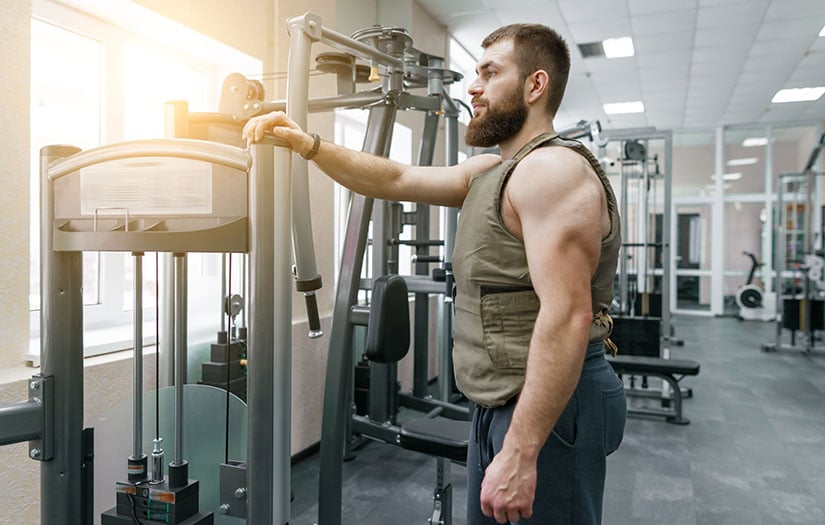When your workout has a “why” behind it, it can be all the motivation that you need to push yourself to complete it. In CrossFit, the notoriously intense Murph workout has a “why” behind it that has encouraged tens of thousands of people to push themselves to the limit each Memorial Day.
This workout honoring fallen Navy hero Lt. Michael Murphy will challenge your physical and mental strength and endurance like it’s never been tested before. To successfully complete your first Murph, use these tips to help you prepare.
If you are in the military and want a discount on select NASM products, check out the military discount page for trainers.
What is a MURPH Workout?
The Murph workout is known as a Hero WOD (workout of the day) in the CrossFit community. This workout honors the life of Lieutenant Michael Murphy- a Navy SEAL who was killed in Afghanistan in 2005 while on active duty. The workout was created to honor not only his life, but also all of those who have lost their lives in active service. It is now considered the Memorial Day workout of the day- performed within and even outside of the CrossFit community.
Here’s the Murph workout:
• 1 Mile run
• 100 Pull-ups
• 200 Push-ups
• 300 Squats
• 1 Mile run
• Performed wearing a weighted vest: 14 pounds for women, 20 pounds for men.
The run is completed first in its entirety, and then you have the option to partition, or break up, the reps of the pull-ups, push-ups, and squats, or you can complete each section before moving on to the next, finishing with the 1-mile run. No matter how you break it down, it’s a tough workout!
How to Train Effectively for a MURPH?
Now that you know what the Murph entails, the first thing that you want to do is to make sure you can do each of the movements well. The OPT Model is set up to help anyone, beginner or advanced, work toward this physical challenge while also minimizing the risk of injury. Plus, a certified trainer can conduct a series of assessments to help you customize your training by helping you correct any faulty movement patterns.
Recommended Phases of Training to Prepare for Your First Murph:
Phase 1: Stabilization Endurance
• Goal: Develop proper movement patterns and improve mobility and stability of the entire kinetic chain.
• Acute Variables: 15-20 reps, 1-3 sets, slow tempo.
• Length of time in Phase: 4-6 weeks.
Phase 1 Exercise Variations:
Pull-ups
See how to do a pull-up: https://www.nasm.org/exercise-library/pull-up
You can modify this move by:
• Adding a resistance band.
• Jumping up to bar height using a box, and then slowly lowering down (doing negatives).
• Starting with a Suspension trainer row.
Push-ups
See how to do a push-up: https://www.nasm.org/exercise-library/push-up
You can modify this move by:
• Using an elevated surface to place your hands, like a countertop, bench, or racked barbell at the height that allows you to perform the move with good form and proper tempo.
Squats
See how to do a squat: https://www.nasm.org/exercise-library/prisoner-squat
*This video is a prisoner squat with the arms behind the head. For a regular squat, let the arms hang down to your sides, or keep them bent in an athletic position.
You can modify this move by:
• Performing a ball wall squat (with a ball behind your back, against a wall).
• Holding onto a suspension trainer, facing the anchor.
Phase 2: Strength Endurance
• Goal: Increased stabilization endurance, hypertrophy, and strength.
• Acute Variables: 8-12 reps, 2-4 sets, medium tempo for strength exercise, slow tempo for stabilization exercise.
• Length of time in Phase: 4-6 weeks.
Phase 2 Strength Exercises:
*Use supersets in this workout by pairing one of the strength exercises below followed immediately with one of the stability exercises from phase 1 for the same movement.
Pull-ups
• Lat pulldown on a machine
• Seated rows. This one is best paired with a suspension trainer row to help you build back strength as you work toward doing your first pull-up.
Push-ups
• If you can perform regular push-ups with good form, you can try adding a light weighted vest, adding weight over time as your form allows.
Squats
Next Steps:
Once you’ve gone through Phases 1 & 2 once, cycle back through again and try a more challenging variation or add weight as needed to increase the challenge.
Running: Once you’ve gone through these two phases once, you can begin to incorporate some running. Why wait? Running is considered a power move that requires skill. Developing good movement mechanics first is essential to being able to run pain-free and without compensations that may put you at risk for injury. Start slowly with shorter running intervals (ex: jog 30 seconds, walk 1:30-2 minutes) and build from there. You can find running apps that will progress you appropriately.
Start with a Weighted Vest or Go Smaller?
It’s best to begin using just bodyweight, and to work on perfecting your form and building endurance before adding any additional weight. The CrossFit pros recommend waiting until you can perform 15-20 unbroken strict pull-ups before adding a weighted vest.
Benefits of Circuits in the Context of the MURPH Challenge
Performing the Murph challenge in the partitioned format is similar to performing a circuit workout, where you perform one exercise after the other back-to-back with little to no rest and repeating for multiple rounds. There are several benefits to training circuit-style:
• Built-in rest time. Each exercise focuses on a different muscle group, so when you move on to a different exercise you are allowing the previous muscle group to rest before you get back to it. I’m not saying this workout feels restful by any means, but your muscles do technically get a small break compared with the unpartitioned format.
• Higher heart rate = higher calorie burn. In general, a circuit workout burns more calories in less time than a workout where you work and then rest before completing the next round of the same exercise.
• Condensed overall work time. Because of the above two benefits, your overall workout time is shorter than following an unpartitioned format.
What is a ‘Good’ MURPH Time?
What’s considered a good time is relative to the exerciser. If you’re a beginner, less than 60 minutes is considered a good finish time. For exercisers who are advanced, you’ll want to complete it in less than 45 minutes, and for elite athletes, less than 35 minutes. Following an unpartitioned format will take the longest. The current verified world record for an unpartitioned and weighted Murph is 32 minutes and 41 seconds, completed by Alec Blenis in June of 2021.
Putting it all together:
When you are ready to put it all together, you have options for how you can attack the workout. You will always perform the one mile run first and last, but the pull-ups, push-ups, and squats can be performed either partitioned (split up circuit-style) or unpartitioned (completing all reps for one category before moving on to the next). One of the most popular ways to partition the reps is to perform 20 rounds of the ‘Cindy’ WOD – 5 pull-ups, 10 push-ups, 15 squats.
However, you split it up, don’t forget to keep track of your rounds so you don’t lose count of your reps! If you decide to do more consecutive reps at a time, make sure you select several reps that you can perform easily, without fatiguing the muscles.
After a few months of consistent and intentional training, you’ll be more than ready to honor our fallen heroes as you complete your first Murph.

















